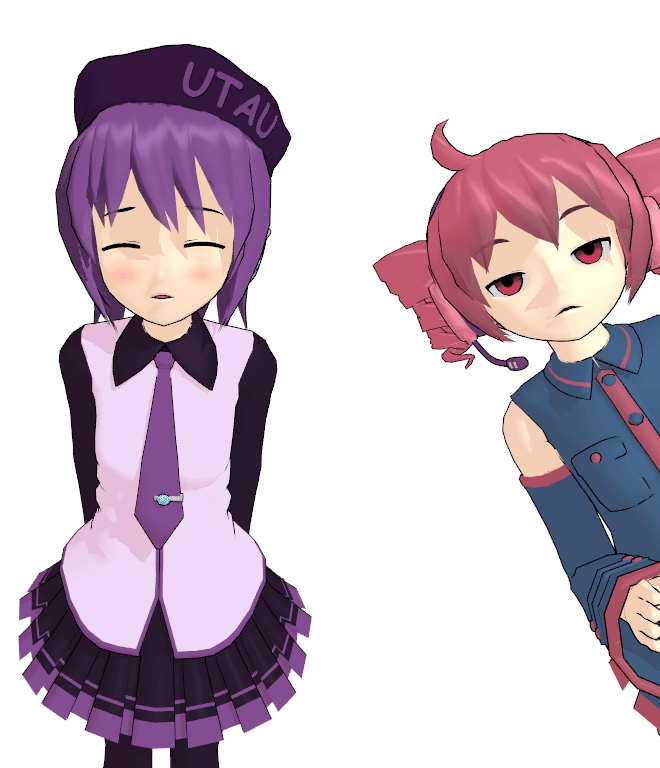Vocaloid, UTAU, Vtubers And Synthesized Vocals – Part 2
So ok, sure – Vocaloid is pretty neat and Miku is super cute. But her personality is just so.. well.. wait, what is her personality like again? Also, what’s UTAU and what does it mean?
====> Make sure to catch Part 1 here! <====
Also, before we get into it, check out the full article in video form below!
Miku’s Personality
The truth is that Miku has no personality, yet at the same time is holding an infinite number of personalities – similar to a blank canvas where anybody can paint their own colors – unlike later Vocaloids like Len, Rin, Luka, and others. As mentioned before, Crypton Future Media believed that in order to popularize their Vocaloid 2 release, they had to leave her personality as a blank slate to entice producers. To add a little bit of flavor for direction, the only information they gave was their setting of her being “an android diva in the near-future world where songs are lost.”
As for the character design and box art, they were conceived and illustrated by manga artist Kei Garou. His goal? – to make Miku look like a cute personification of the Vocaloid 2 software. It’s easy to see that the design on her skirt and boots are based off of the software’s color scheme and the bars on her arms are supposed to look like an equalizer. As for the hair design, the twin-tail hairstyle was chosen only after throwing away a previous design later in the process (can you even imagine a short-haired Miku?!).
The Vocaloid Debut
The first song that was ever composed using Miku’s voice is the iconic “Hoshi no Kakera”, or “Ballad” as it was called during the pre-release promo. Composed by Eiji Hirasawa, this song was meant to show off how good of a singing voice could be synthesized by producers who have never dabbled in this sort of music. Not only that, but the video stresses the character Hatsune Miku herself and creates a feeling of an existence behind the voice
Check out this cool interview with Eiji Hirasawa about his experience composing this song
This, along with a few other pre-release songs such as “Kakurenbo” and “Pops” generated hype and paved the way for more Miku covers and original songs. As a testimony to her popularity, Miku’s voice has been featured in over 100,000 original Vocaloid songs according to Crypton’s 2011 advertisement. Since her release, many composers and groups have started to form and publish music made explicitly with Miku in mind (many of these Japanese users have “-P” appended to their handles to signify that they are a ‘producer’). Among the most famous early Vocaloid composers is one of my favorites, the 11 member doujin music group called Supercell.
Vocaloid Agencies – Supercell
The group Supercell (I suspect the name Supercell is meant to stand for “a rotating thunderstorm of emotions”) was originally formed by a Nico-dou songwriter named Ryo, albeit unintentionally. In 2007, Ryo submitted his song “Melt” using Miku for the vocals and cover art drawn by a well known illustrator – the song immediately turned heads and became an instant hit with over 5 million views to date.
But it turned out that the cover art which he had used on the video was taken from the artist 119 (pronounced Hikeshi, actual name Shirou Miwa) without his permission which put Ryo in an uncomfortable situation. When Ryo was persuaded to contact 119 and give him a formal apology, he was received by anything but an angry illustrator. Interested in his composing skills, 119 began to work together with Ryo as the second official member of Supercell, a group which would eventually rank #4 on the Oricon charts in Japan.
According to Ryo, he never meant to make it big with the release of “Melt” and originally didn’t even considering using Miku. But with just a few suggestions from his friends and a chance encounter with 119, the fateful choice was made which eventually led to the creation of this popular group (so I suppose it was a good thing he used that art without permission?).
MikuMikuDance
You may have noticed, but many Vocaloid songs these days are not just songs – they are videos. This feature which is really unique to the Vocaloid culture stems from a piece of software released in 2008 called MikuMikuDance, written by HiguchiM of the VOCALOID Promotion Video Project.
As the name implies, the freeware is meant to enable producers to create nice looking, cell-shaded animations of 3D models for Vocaloid music videos. It’s meant to be fairly simplistic in terms of controls and allows 3D animations to be scripted with relative ease (they even have Kinect plugins now). I won’t go too in-depth, but it is conceivable for someone with no prior knowledge of modelling to create a simple animation within a day.
MikuMikuDance really helped in spreading the Vocaloid hype – emotions that may not have been properly conveyed through music could be added in as 3D detail in the videos, amplifying the message and increasing the production value. Not long after the initial release, fan-made models started popping up and users who had never produced music started to make videos and choreographies for songs – these users not only used the base Miku model, but were enthusiastic about using other Vocaloids, modified characters, custom clothing and specially made models in general. Although the wide reach of this software resulted in many low quality models and ridiculous animations, there were plenty of successes and more importantly, this interest is part of how the UTAU culture started and grew.
The Vocaloid Idealogy
But before we get into what UTAU actually is, it’s important to understand the general ideology held by Vocaloid producers and fans in Japan at the time. In its early days, the Vocaloid voice synthesizer was very good at producing understandable and melodic vocals, but they were easily distinguishable from real human voices in that they had a prominent robotic tone. Only the best producers were able to push the sense of reality to the limits and even then, the results were far from perfect.
In the US, the kind of robotic voice that the early Vocaloid software produced was seen as ugly and unskilled by most people, but in Japan it was received quite differently. The slightly robotic nature of Vocaloids, and Miku in particular, gave them a sense of character and made these songs stand out in particular. Warmly received, the syncopation of their voices and the understanding of their origins not only showed the skill level of the producer, but helped in defining a core value of the Vocaloid culture. This is part of the reason why even now with major software advances in the Vocaloid synthesizer, a lot of producers still stick to their slightly robotic roots (with the exception of odd things like Voiceroids). The yearning for this robotic sounding music was so strong that people started to upload a new style of music called Jinriki Vocaloid (人力ボーカロイド – “Human powered Vocaloid”).
Jinriki Vocaloid
I can’t embed NicoNicoDouga videos, so you’ll just have to follow this link to the Jinriki Vocaloid version of Utada Hikaru’s song “Kokoro”.
The Jinriki Vocaloid fad used to be a common practice on Nico-dou, which involves re-editing an existing singing voice (usually a popular singer or anime character) and extracting tones as WAV files to reconstruct songs. Sometimes the same exact songs are created just to give it the feeling of a Vocaloid (think of it as reverse auto-tune). But the fact of the matter is that this form of creating Vocaloid vocals is very limited and extremely time consuming – imagine clipping a full song, extracting all of the phonemes, and pasting them together in the correct order with perfect timing.
The song above is an example of a Jinriki Vocaloid version of Utada Hikaru’s song “Kokoro.” Utada herself has actually praised this fan-made version of her song on twitter, though these days covers like this are rare and the sub-culture has been dying out. But this shift isn’t because of people’s lack of interest, it’s because they’ve found an easier way to get the results they want with much less effort – and this method is UTAU.
UTAU
UTAU is a Japanese singing voice synthesizer created by Ameya/Ayame (aka Ameya-P) which is meant to be a freeware counterpart to Vocaloid and is the software version of the Jinriki Vocaloid method. Released in 2008, the concept behind UTAU (which means “to sing” in Japanese) is identical to that of Vocaloid in that they both use voicebanks to synthesize vocals based on directives like pitch and portamento.
But when comparing UTAU and Vocaloid, the biggest and single most important difference is in the licensing scheme for voicebank creation. With the UTAU software, you are free to create voicebanks by recording your own voice into WAV files which would later be split – similar to how Jinriki Vocaloids were produced, but more automated. Any voicebank created using this method is the property of the person who provided the donor voice, and they have full control over how it is used.
UTAU Defoko
Released as a demo, Defoko (デフォ子 – from “default” and ko, “girl”) is the original voicebank that ships with the software, later to be known as Utane Uta (唄音ウタ – from uta, “song”, and ne, “sound”) and given her own characterization as a slightly sadistic girl. Uta herself is a sort of 2nd generation voicebank since her voice was created by sampling the AquesTalk voice synthesizer. The concept of this self-made voicebank really appealed to a particular subset of doujin music creators – namely the large percentage of people who didn’t have any musical talent or production skills, but still wanted to create Vocaloid-like works and make a name for themselves on sites such as Nico-dou and YouTube.
The Introduction of Kasane Teto
For the most part, the vast majority of these people were artists who wished to further develop their original characters by means of UTAU and MikuMikuDance. These fan-made characters are colloquially known as “UTAUloids” in reference to Vocaloids and although the quality ranges from bad to mediocre, some of them have made it into the spotlight. One particular UTAUloid who has become as popular as Crypton’s own Vocaloids is a twin-drill, baguette loving girl who goes by the name of Kasane Teto.
Kasane Teto is the first widely popular UTAUloid and the girl who made the UTAU software famous to begin with. Teto was released as part of an April Fool’s joke in 2008 by a group of 2ch users called “VIPPERS” (users who frequent the Vip News Bulletin@2ch).
The project began not with an UTAU voicebank, but just the concept of a fake Vocaloid character slated to be released on that day. Sporting an “04” as her Vocaloid number (0401 in some versions), Teto was a major success on April 1st as everybody was fooled into believing that she was the “new VOCALOID release” of that time. Voiced by Mayo Oyamano who posed as Nobuyo Ooyama, the voice of Doraemon, all major search engines and news sources published the release and crazy hype was generated.
A little background on her – Teto, whose name stems from Tetopettenson, is said to be a chimera (hybrid of human and bat) and is actually 31 years old, although it is claimed that her ‘chimera-age’ is only 15.5 which gives her the appearance of a young girl as a human. To antagonize those who believed that she was an actual Vocaloid, her favorite phrase was made to be “君は実にばかだな (kimi wa jitsu ni baka dana)” which means something along the lines of “Well, aren’t you truly an idiot?” VIPPERS made sure to come up with as ridiculous a story as they possibly could for this girl and they succeeded in creating something really unique.
But as people found out that Teto was just a prank, interest died down and she slowly faded back into the noise. Luckily, UTAU was rising in popularity so they decided to create an actual voicebank for Teto by re-recording Mayo’s voice. The group TWINDRILL took on the Teto Project and the legacy of this fake Vocaloid is still present in many fan-made videos (If anybody was wondering, the Teto song above is based off of Kero ⑨ Destiny).
Other UTAUloids
VIPPERS have also created many more UTAUloids, more commonly known as VIPPERloids for their 2ch origins. Following their success with Teto they continued to create VIPPERloids, most of which have absurd and amusing personalities with hyperbolic backstories. A popular example is the 6 year old male VIPPERloid who loves to crossdress, Ritsu Namine.
Ritsu Namine
The funny part about Ritsu is that the official information provided by VIPPERS is so absurd that fans just ended up creating their own, more reasonable traits. For example, in the canon he weighs 25 tons which is attributed to the missiles that were built into his torso (haha what?). Fans found this ridiculous and decided that it would make more sense to just say that he is wearing a padded bra and that his actual weight is something more reasonable, say around 165lbs (“reasonable” for the fan-made age of 18).
Even more interesting is his dark personality – he loves to bully people by means of purple nurples, is a misanthrope, and holds Korean culture in much higher regard when compared to Japanese. Surprisingly, Ritsu has a pretty good voicebank for a VIPPERloid, with some of his more notable songs being pretty popular. But if you think Ritsu is depraved, wait until you hear about this next VIPPERloid.
Tei Sukone
Another very amusing VIPPERloid is Tei Sukone, whose name is a pun on Scottie, a brand of tissue paper made in Japan. Tei was developed to be another troll Vocaloid, similar to Teto, but was released with an actual voicebank. Just like Teto, her released fooled many people into believing she was a Crypton Vocaloid which made VIPPERS successful once again.
But unlike the first time this happened, there was a certain degree of disdain towards VIPPERS and because of that, Tei was born into hatred, having been used solely to deceive people. And as if to antagonize the situation, her personality is quite dark as well – she is a yandere whose crush on Len, a Crypton Vocaloid, causes her to become violent whenever others are around him. Not only does she harbor a deep seated hate for all other Vocaloids, but she is always trying to kill Miku in order to take over the leading Vocaloid/UTAUloid status. Her obsession with Len and hatred of Miku has stirred the emotions of many fangirls and she has quite the reputation among trolls for her amazing ability to make people immensely angry (this song pretty much sums up her craziness).
VIPPERloids in General
As you can see, VIPPERloids and UTAUloids are much more likely to have warped personalities because of their fan-made roots, even though Vocaloids were also released as blank slates and later personified by their users.
The Rise of Vtubers
Vocaloid has developed into a culture beyond anybody’s wildest dreams at the time of its creation. The various sub-cultures it spawned shape many people’s lives and have become a source of inspiration for many (including me). Miku rode the wave through the collective efforts of everybody involved and she has even received a letter from the Japanese Minister of Economy himself, praising her for “contributing to the furtherance of informatization.” Because of Crypton’s amazing vision, people now see Miku as they would any other anime character plus a lot more – performing concerts worldwide (Taipei, Hong Kong, NYC?!) she has truly become a virtual diva in today’s world, trying to prevent the “future world devoid of music.”
But just as Vocaloids spawned the many subcultures of doujin works, each of these subcultures spawned many others – the most notable being Vtubers, or Virtual Youtubers. From the rise of the the OG Vtubers like Ami Yamato or Kizuna Ai, to creators with more current fame like Gawr Gura or CodeMiko. More on this and other Vocaloid inspired software in Part 3 (not out yet)!
–
====> Make sure to catch Part 3 here (not out yet)! <====








